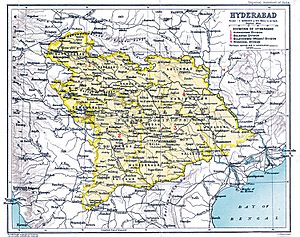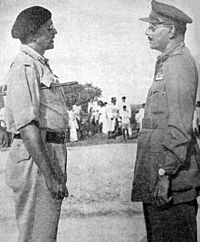Annexation of Hyderabad facts for kids
Quick facts for kids Operation Polo |
|||||||
|---|---|---|---|---|---|---|---|
 The State of Hyderabad in 1909 (excluding Berar) |
|||||||
|
|||||||
| Belligerents | |||||||
| Commanders and leaders | |||||||
|
|
||||||
| Strength | |||||||
| 35,000 soldiers | 222,000 total
|
||||||
| Casualties and losses | |||||||
| <10 killed | 5,738+ total
|
||||||
|
|||||||
Operation Polo was the name given to a military action in September 1948. The newly independent country of India took action against Hyderabad State. This operation led to Hyderabad joining the Indian Union.
When India became independent in 1947, many small kingdoms, called princely states, existed. These states had some self-rule but were under British control for their foreign affairs. After the British left, these states could choose to join India, Pakistan, or become fully independent.
Most states joined either India or Pakistan by 1948. However, Hyderabad, a large and wealthy state, chose to be independent. Its ruler, Mir Osman Ali Khan, known as the Nizam, was Muslim, but most of his people were Hindu. He hoped to keep Hyderabad independent with his own army. The Nizam also faced a local uprising called the Telangana rebellion.
In November 1947, Hyderabad signed an agreement with India. This agreement kept things mostly the same, but Indian troops left Hyderabad. India later invaded Hyderabad in September 1948. This happened after economic problems and attempts to cause trouble in the state. After the Nizam's forces were defeated, Hyderabad joined India. Sadly, this operation led to violence, and many people lost their lives.
Contents
Hyderabad's Past
After a big battle in 1687, the region of Hyderabad became part of the Mughal Empire. In 1724, a leader named Qamar-ud-din Khan became its ruler, known as the Nizam. Hyderabad became a princely state under British protection in 1798.
The 7th Nizam, Mir Sir Osman Ali Khan, ruled Hyderabad. It was the largest and richest princely state in India. It covered a huge area and had about 16.34 million people in 1941. Most of these people (85%) were Hindu.
Hyderabad had its own army, airline, and money. People spoke Telugu, Marathi, Kannada, and Urdu. Even though most people were Hindu, Muslims held most of the important jobs in the government, police, and army. The Nizam and his nobles, who were mostly Muslim, owned a lot of the land.
When the British left India in 1947, they gave princely states three choices. They could join India, join Pakistan, or become independent. Hyderabad chose to be independent. Leaders in India worried that if Hyderabad stayed independent, other parts of India might also try to break away.
Over time, Hyderabad became more focused on Muslim identity. In 1926, a group called the Majlis-e-Ittehadul Muslimeen (MIM) was formed. Its goal was to unite Muslims and support the Nizam. This group became very powerful.
Before the Conflict
Talks and Agreements
The Nizam of Hyderabad, Mir Sir Osman Ali Khan, first asked the British to let Hyderabad be an independent country. But the British leader, Lord Mountbatten, said no.
When the British left India, the Nizam said he would not join India or Pakistan. He even tried to make deals with European countries. He wanted to buy or lease Goa to get access to the sea.
Indian leaders had different ideas. Prime Minister Jawaharlal Nehru wanted Hyderabad to join India peacefully. He saw military action as a last choice. But Vallabhbhai Patel, another strong leader, wanted quick action.
India offered Hyderabad a standstill agreement. This meant things would stay the same for one year, and no military action would be taken. Indian troops would also leave Hyderabad. But a group called the Razakars protested against this agreement. They forced the Nizam's ministers to resign.
Hyderabad broke parts of the agreement. It secretly loaned money to Pakistan and built up its army. It also caused problems with railway traffic. India was also accused of blocking supplies to Hyderabad.
The Nizam tried to get help from the United Nations, but he was not successful.
Telangana Uprising
In 1945, a peasant uprising began in the Telangana area. This was led by communists. Poor farmers were unhappy with the land system. The communists gave land to the poor and improved their lives.
At first, the communists fought against wealthy landowners. But soon, they started a full revolt against the Nizam. The conflict between the Razakars and the communists became very violent.
Hyderabad's Military Strength
The Nizam's army was not very big, with only about 24,000 soldiers. Only about 6,000 of them were well-trained. They were made up of different groups, including Arabs and North Indian Muslims. The army had armored vehicles, cavalry, and infantry.
In addition, there were about 200,000 irregular fighters called the Razakars. They were led by Kasim Razvi. About a quarter of them had modern guns, while others used older weapons like swords.
First Clash at Kodad
On September 6, 1948, Razakar units attacked an Indian police post. The Indian Army sent troops to investigate. They were also fired upon. Indian tanks chased the Razakars into Hyderabad territory, to a town called Kodad. In a short fight, the Indian forces defeated the state's soldiers there.
India's Military Plan
India decided to take control of Hyderabad. The Indian army made a plan called the Goddard Plan. It involved two main attacks: one from the East (Vijayawada) and one from the West (Solapur). Smaller groups would also keep the Hyderabadi army busy along the border.
Major General Jayanto Nath Chaudhuri led the attack from Solapur. Major General Ajit Rudra led the attack from Vijayawada. Indian planes were also ready to provide support from the air. The attack was set for September 13.
The Conflict Begins
Day 1: September 13
Indian forces entered Hyderabad at 4 a.m. The first battle was at Naldurg Fort. Indian soldiers quickly secured a bridge and moved into the town of Jalkot. An armored column reached Umarga, 61 km inside Hyderabad, by the afternoon. They easily defeated the Razakars there.
Another Indian group attacked Tuljapur, about 34 km north-west of Naldurg. They faced resistance for two hours before the Hyderabadi soldiers surrendered. The first day ended with India gaining a lot of territory and causing heavy losses to Hyderabad.
In the East, Indian forces faced strong resistance from Hyderabad's armored cars. But they managed to reach Kodar by 8:30 a.m. and Munagala by the afternoon.
Day 2: September 14
The Indian forces from Umarga moved towards Rajeshwar. Indian planes helped clear the way by attacking enemy positions. The ground forces reached and secured Rajeshwar by afternoon.
The attack from the East was slowed by a ditch and heavy fire from Hyderabadi soldiers. But Indian Gurkha soldiers, who were very experienced, attacked and cleared these positions.
At the same time, other Indian troops attacked Osmanabad. They fought hard against the Razakars in the streets and took the town. Indian forces also captured Aurangabad after a battle.
Day 3: September 15
Indian forces continued to advance. They moved to Latur and then to Mominabad. Here, they faced some resistance from Hyderabadi soldiers, who soon surrendered.
At Suryapet, air strikes helped clear most of Hyderabad's defenses. Indian soldiers occupied the town. The retreating Hyderabadi forces destroyed a bridge to slow the Indians, but it was quickly repaired.
Day 4: September 16
Indian troops moved towards Zahirabad. They were slowed by a minefield, which had to be cleared. They faced some ambushes from Razakar units in towns. The Razakars used the buildings to their advantage, but the Indians used their powerful guns to clear them out.
Day 5: September 17
Early on September 17, the Indian army entered Bidar. Other Indian forces were close to Hyderabad City. By the morning of the fifth day, it was clear that the Hyderabad army and the Razakars had been completely defeated. At 5 p.m. on September 17, the Nizam announced a ceasefire, ending the fighting.
Surrender and Aftermath
Nizam's Decision
On September 16, seeing that defeat was certain, the Nizam Mir Sir Osman Ali Khan asked his Prime Minister, Laiq Ali, to resign. The Prime Minister and his entire cabinet resigned the next morning.
On September 17, the Nizam called India's representative, K. M. Munshi. The Nizam told him, "The vultures have resigned. I don't know what to do." Munshi advised the Nizam to ensure the safety of his people. The Nizam immediately ordered his army commander to surrender.
Nizam's Radio Message

The Nizam of Hyderabad, Mir Sir Osman Ali Khan, spoke on the radio on September 23, 1948. He said that a small group, meaning the Razakars, had forced his trusted ministers to resign. He said this group, led by Kasim Razvi, took control of the state and caused fear.
The Surrender Ceremony
According to Indian Army records, General Chaudhari entered Hyderabad on September 18. The Hyderabad army, led by Major General El Edroos, officially surrendered.
Hyderabad Joins India
Detentions and Releases

After the operation, the Indian military held many people. These included Razakars and others. Many people were detained based on information from locals, which sometimes led to old arguments being settled. This caused jails to become very crowded.
The Indian government set up special courts to deal with these cases. There were some problems with these trials. The government decided to release many people, especially Hindus, and review the cases of Muslims. By 1953, most people had been released.
Changes in Government
New officers from nearby regions were appointed to replace old officials in Hyderabad. These new officers often did not speak the local language and were not familiar with the area. Prime Minister Nehru was concerned about these changes.
See Also
- Political integration of India
- Princely state
Images for kids






